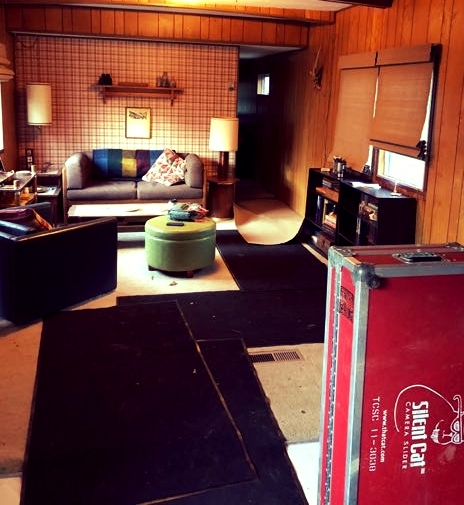Part II: Interiors
Typically, during the shoot, except for the on-set crew members, you don’t see many of the Art and Set Decoration crew members: they come weeks, days, hours before, creating and transforming the spaces. But at the Freeman’s property, I get the opportunity to finally meet a few of them and watch them work.
Debbie De Villa, Production Designer in the Art department, oversees and designs all the sets, and she’s done such a brilliant job. I follow her into the church, where tomorrow there will be a flashback scene with Cole and his grandfather. While the grips and electricians work on the lighting and getting the church ready for the shoot, the set decorators and dressers put the final touches on—flowers, framed pictures of Bible quotes that they found in a church nearby. It’s really the perfect church for the Freemans, and even with all the activity, it feels peaceful. I’m looking forward to seeing tomorrow’s flashback scene, when Clyde Freeman preaches.
Later, I walk into Cole’s trailer, to warm my frozen toes but also just to be in Cole’s space. It’s another perfect set, imagined and designed with thoughtfulness, care, and creativity. I scan the books on the neat, compact bookshelf, and notice a nursing book and James Baldwin’s Go Tell It On The Mountain. A writing exercise I give my students is to describe your character’s bedroom. It’s a great way to give you insight into the character, and to reveal the character without explaining. And, that’s similar to what the set designer does (but on a much bigger scale); she reads the script and begins to imagine: where does this character live, and what does this space reveal about him? What do objects, rooms, decorations tell you about a person, about his story?
Cole’s living room reveals his quiet, muted, but observant personality; his tidiness and need to control some part of his life; his connection to nature and wildness; his habits of smoking and maybe drinking a little too much; his love for his grandparents. Plaid wallpaper, the simple brown couch brightened with a colorful pillow; neat arrangement of lamps and side tables. A picture of his grandfather; pack of cigarettes; bottle of Tylenol; ashtray; neatly stacked National Geographic magazines.
Later, On-Set Dresser Chris Reisz takes pictures of the scene with his phone when it’s up on monitor, checking for continuity and to make sure nothing is out of place. Sometimes the crew comes through and will accidentally move something, or someone will set down a coffee cup, and Chris has to track all of this: grab the misplaced coffee cup or straighten a picture on the wall. Cole’s trailer is supposed to look tidy and neat, but Braden had mentioned it needed to look more lived-in, so Chris set out a bowl of Cheerios and left out a half gallon of milk on the counter. Those little kinds of details turn a set into a real space—so when we’re watching the film, we’re not seeing a set, but Cole’s home. I think of author and critic John Gardner’s point that a novel must be a “vivid, continuous dream.” Every detail matters—whether it’s a book on a shelf, or the bowl of cereal on the counter—because you never want the reader, or in this case the viewer, to bump out of the continuous dream.





